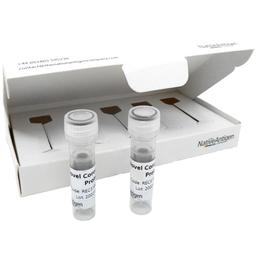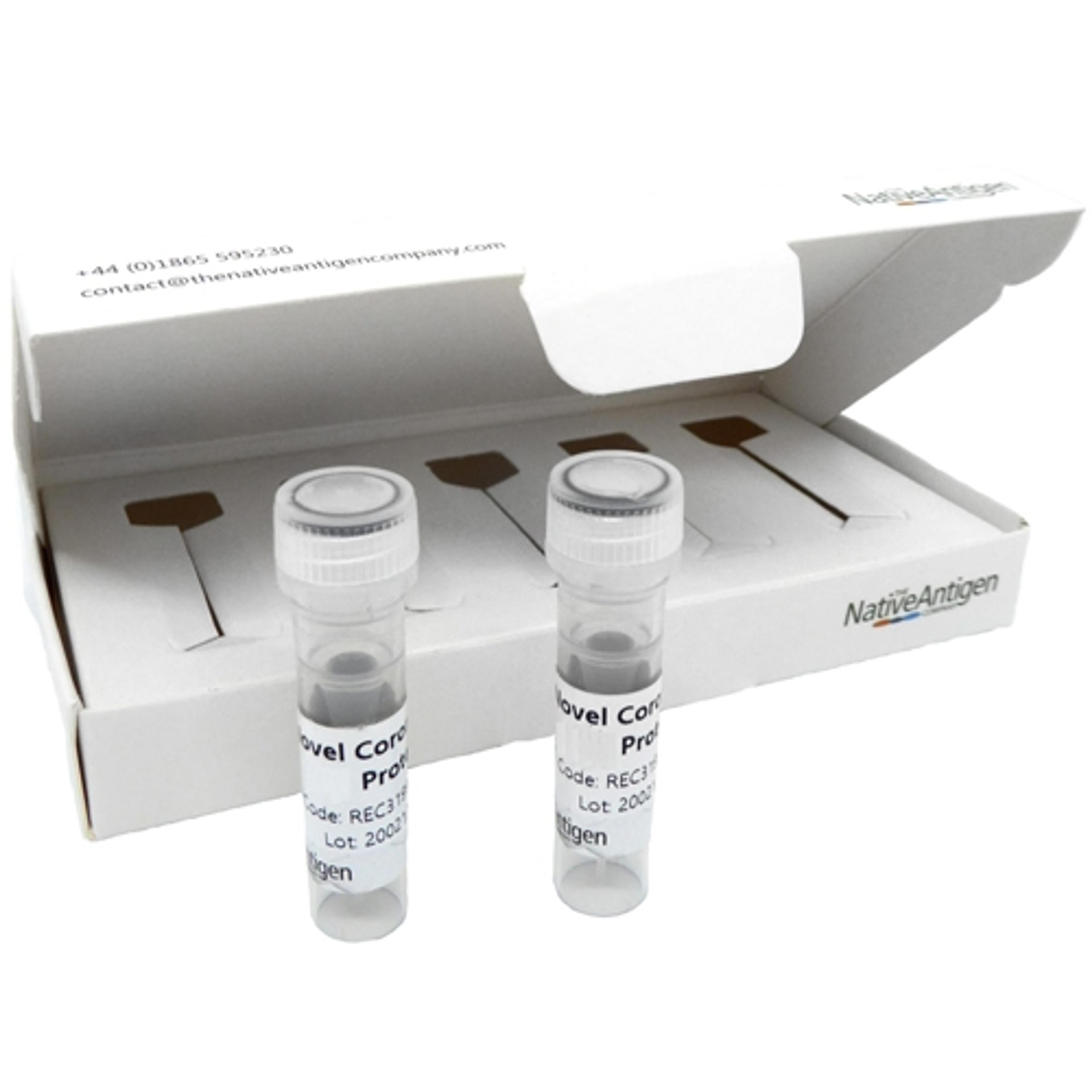SARS-CoV-2 Spike-E-M Mosaic Protein, His-Tag (E. coli)
SARS-CoV-2 Spike-E-M Mosaic protein is a recombinant antigen manufactured in E. coli with greater than 95% purity, and containing the Spike (S), Envelope (E) and Membrane (M) immunodominant regions. SARS-CoV-2, previously known as the 2019 Novel Coronavirus (2019-nCoV), causes the pandemic COVID-19 disease.
SARS-COV-2 SPIKE-E-M MOSAIC PROTEIN, HIS-TAG (E. COLI)
SARS-CoV-2 Spike-E-M Mosaic protein is a recombinant antigen manufactured in E. coli and containing the Spike (S), Envelope (E) and Membrane (M) immunodominant regions. SARS-CoV-2, previously known as the 2019 Novel Coronavirus (2019-nCoV), causes the pandemic COVID-19 disease.
PRODUCT DETAILS – SARS-COV-2 SPIKE-E-M MOSAIC PROTEIN, HIS-TAG (E. COLI)
- SARS-CoV-2 Spike-E-M Mosaic protein.
- Recombinant protein manufactured in E. coli cells with >95% purity.
- Contains Spike (S), Envelope (E) and Membrane (M) immunodominant regions, with C-term 6xHis-tag.
- Presented in PBS.
BACKGROUND
In late December, 2019, a number of patients with viral pneumonia (now called 2019-nCoV acute respiratory disease) were found to be epidemiologically associated with the Huanan seafood market in Wuhan, in the Hubei province of China. A novel, human-infecting coronavirus, provisionally named 2019 Novel Coronavirus (2019-nCoV) and since named SARS-CoV-2, was identified by genomic sequencing (Lu et al., 2020). SARS-CoV-2 is closely related (88% identity) to two bat-derived severe acute respiratory syndrome (SARS)-like coronaviruses, collected in 2018 in Zhoushan, eastern China, but were more distant from SARS-CoV (~79% identity) and MERS-CoV (~50% identity). However, although bats might be the original host of this virus, an animal sold at the seafood market in Wuhan may have acted as an intermediate host (Lu et al., 2020). Relative synonymous codon usage (RSCU) analysis suggests that SARS-CoV-2 is a recombinant between the bat coronavirus and an origin-unknown coronavirus, and it has been proposed that a snake could have acted as the reservoir. The recombination event occurred within the viral spike glycoprotein (Ji et al., 2020). Homology modelling shows that SARS-CoV-2 has a similar receptor-binding domain structure to that of SARS-CoV, despite amino acid variation at some key residues. Therefore, SARS-CoV-2 may be able to bind to the angiotensin-converting enzyme 2 (ACE2) receptor in humans (Lu et al., 2020).
SARS-CoV-2 is a respiratory virus which causes coronavirus disease 2019 (COVID-19); it spreads primarily through contact with an infected person through respiratory droplets generated when a person coughs or sneezes, or through droplets of saliva or discharge from the nose. The incubation period is believed to range from 2-11 days. Infection with SARS-CoV-2 can cause mild symptoms including a runny nose, sore throat, cough, and fever. However, it can be more severe for some people and can lead to pneumonia or breathing difficulties. The elderly, and people with pre-existing medical conditions (such as, diabetes and heart disease) appear to be more vulnerable to becoming severely ill with the virus. There are currently more than 40,000 confirmed cases from 24 countries, although the vast majority are still within China, with more than 900 deaths to date (WHO, 2020).
Coronavirus particles form a helical nucleocapsid structure between nucleocapsid (N) phosphoproteins and the viral genomic RNA, which is surrounded by a lipid bilayer. A number of structural proteins are inserted into this including the spike (S), the membrane (M), and the envelope (E) proteins. The coronavirus spike (S) glycoprotein is a class I viral fusion protein on the outer envelope of the virion that plays a critical role in viral infection by recognizing host cell receptors and mediating fusion of the viral and cellular membranes (Li, 2016). M is the most abundant envelope protein and sorts viral components to be incorporated into virions and drives the assembly of coronavirus, which bud into the lumen of the endoplasmic reticulum-Golgi intermediary compartment (ERGIC). E is a viroporin that forms ion channels and plays an important role in virus assembly, budding, envelope formation, and pathogenesis (Schoeman et al., 2019; Siu et al., 2008).
REFERENCES
- Gallagher and Buchmeier (2001). Coronavirus spike proteins in viral entry and pathogenesis. Virology. 279(2):371-4.
- Ji et al. (2020). Homologous recombination within the spike glycoprotein of the newly identified coronavirus may boost cross-species transmission from snake to human. J Med Virol. 2020;10.1002/jmv.25682. doi:10.1002/jmv.25682.Li F. (2016). Structure, Function, and Evolution of Coronavirus Spike Proteins. Annu Rev Virol. 3(1):237-261.
- Lu et al. (2015). Bat-to-human: spike features determining ‘host jump’ of coronaviruses SARS-CoV, MERS-CoV, and beyond. Trends Microbiol. 23(8):468–78.
- Lu R, Zhao X, Li J, et al. (2020). Genomic characterisation and epidemiology of 2019 novel coronavirus: implications for virus origins and receptor binding. Lancet. S0140-6736(20)30251-8. doi:10.1016/S0140-6736(20)30251-8.
- Novel coronavirus (2019-nCoV), World health Organisation (WHO), 2020.
- Schoeman D, Fielding BC. Coronavirus envelope protein: current knowledge. Virol J. 2019;16(1):69.
- Siu YL, Teoh KT, Lo J, et al. The M, E, and N structural proteins of the severe acute respiratory syndrome coronavirus are required for efficient assembly, trafficking, and release of virus-like particles. J Virol. 2008;82(22):11318–11330.
- Su et al. (2016). Epidemiology, Genetic Recombination, and Pathogenesis of Coronaviruses. Trends Microbiol. 2016 Jun; 24(6):490-502.






